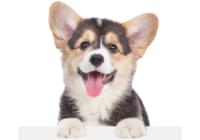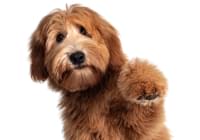Thunderstorm Phobias
Medical Management of Thunderstorm Phobias
Michael Stephan, DVM
Juno Beach Animal Hospital
Let me start by saying that there is no good medication for long-term management of thunderstorm phobias. Medication may be useful for specific events - 4 th of July or New Years - but is not usually successful for everyday use during thunderstorm season. However, some of the drugs listed below may be useful in helping to control the phobias while your dog is undergoing behavior modification to deal with their phobia.
It should also be noted that different dogs will have different responses to different medications. Some of the medications can have serious side effects and should only be used in conjunction with a veterinarian who knows your dogs medical history. It may be advisable, in some cases, to do bloodwork before starting these medications to avoid or minimize side effects.
The slow onset of these drugs, when given orally, makes them unreliable for immediate use. Your dog is likely to hear and react to a coming storm before you do. By the time you give the medication and it takes effect, the storm will most likely have passed. The potential side effects of these drugs make them impractical for everyday use in case a storm comes.
The drugs and doses provided here are for general information only and are not intended to diagnose, treat, or prescribe for any individual dog or any specific condition. Please consult your veterinarian before giving your dog any new medication.
Valerian Root - herbal supplement. Acts as an anti-anxiety drug with some mild sedation. Marketed as a nutritional supplement and is therefore not regulated by the FDA. Wide variation in effect from dog to dog, though this may be a result of the lack of quality control for most products. Available as liquid, capsules, and tablets. Liquid preparations tend to be very bitter and unpalatable.
Dosage is generally 1/4 to 3 tablets per dog or 12 to 150 mg per lb of the dried herb.
NOTE: Extracts are much more potent than dried preparations. Both forms can vary in concentration from manufacturer to manufacturer and from batch to batch from the same manufacturer.
Melatonin - Pineal gland hormone.Dr. Nicolas Dodman (Veterinarian and dog behaviorist at Tufts) is a specialist in the field of Thunder / Noise phobia in animals. He recommends Melatonin (3 mg for a 35 B 100 lbs dog), an over the counter product/food supplement used in people for treatment of insomnia. Melatonin may increase the effects of benzodiazepams.
DAP - Dog Appeasing Pheromone. This is a pheromone that is secreted by skin glands between the mammary glands of lactating bitches. The Pheromones are sold with a plug-in diffuser (like a scented plug in for your home). It is odorless to people but has a calming effect for many dogs. May take a week or more to affect behavior. Should be used in the room where the dog spends most of its time, or where it is confined during storms.
Diphenhydramine - Benadryl. An antihistamine may have some sedative effects in some dogs. It is used commonly as an antihistamine in dogs and sedative effects are widely variable. Some owners report hyperactive behavior.
Dosage is generally 1 mg per pound of body weight two to three times a day.
Clomipramine - Clomicalm. A tricyclic antidepressant used for separation anxiety in dogs. Indicated for short-term use (3-5 months) in conjunction with training. Overdosage with tricyclics can be life-threatening (arrhythmias, seizures, cardiorespiratory collapse).
Acepromazine- a phenothiazine neuroleptic agent. It is used primarily as a sedative and has little or no antianxeity effects. May cause hypotension. It is contraindicated in animals with cardiac disease, liver disease, or seizures.
Alprazolam - Xanax. A benzodiazepine. Antianxiety medication with some sedative effects. Some dogs may have a contradictory response showing increased anxiety and aggression. Contraindicated in dogs with liver or kidney impairment and in aggressive dogs.
Overdosage can result in confusion, coma, decreased reflexes, and cardiac arrest.
CONTROLLED SUBSTANCE
Diazapam - Valium. Like Alprazolam, a benzodiazepine. Drug profile and contraindications are the same as listed of Alaprazolam.
Thunder or Loud Noise Phobia
Karin Vermeegen, June 2008
What is Thunder or Loud Noise Phobia?
Thunder Phobia and extreme fear of loud noises is a relatively common problem in dogs. Thunder and Loud Noise Phobia is a fear that is out of proportion to the real danger of the situation. Dogs literally fear for their life, there may be hardly any communication possible.
The static in the air can make dogs want to escape from their own bodies, the more the behavior occurs the stronger it becomes. Dogs may hide in certain places, may soil in the house, panic, destroy furniture, scratch at doors and windows and can terribly hurt themselves when they try to get away from the source of their fear.
Thunder phobia is most likely to occur in Labrador Retrievers, Golden Retrievers, German Shepherds, Huskys and any mixes of these breeds. Most of the time it becomes a serious problem when the dog is a little older, five years and up.
Comforting
"When your dog is scared of something he should not be scared off and you comfort him by stroking him and telling him its okay may actually make things worse. By comforting your dog at the moment he is scared, you admit to your dog that there is something wrong. You mark the event. Imagine yourself in an airplane when you hear a scary noise. You look at the flight attendants B they are relaxed and do not seem to bother. You can let go of your fear. Imagine now that you hear the noise and the flight attendants come over to the passengers and tell everybody to stay calm that everything will be okay. By doing that they let you know that there was indeed something going on. Thats when you start to panic.
Punishing
Imaging you are scared to death, you fear for your life and your care taker punishes you. That is not going to help. For dogs this means they now not only have to fear the Thunder but also your angry behavior. Punishing a dog with Thunder Loud noise phobia is not fair and absolutely not helpful. Same goes for locking your dog up in a crate B he may harm himself.
Anti-static spray/mats
Some dogs, especially larger dogs with a thicker coat may experience little shocks from the static build-up in the air. It can be helpful to leave the dog in an area where he can unloada bathtub, water pipes, and concrete floor. Most carpets make the feeling of too much static worse. You can use anti-static mats as well.
Anxiety Wrap
The wrap gives dogs the feeling of being hugged and that calms them down instantly.
Start using the wrap when there are no thunderstorms, just to get the dog used to the comforting feeling of the wrap without making a connection with bad things
Environment
Leave calming music on for your dog when you are away and you may consider the use of a plug-in DAP comfort zone. The DAP plug-in releases the scent of hormones, similar to the smell of the hormones of a puppy-mother and can be comforting for some dogs.
Rescue Remedy may help some dogs B it may not do much for other dogs. If your dog feels comfortable in a closet, let your dog stay there while you work on minimizing his fear. Do not force your dog to leave the safe spot.
Treat machine
There is a treat and train machine on the market and something called The Kong Time. Both machines work with a timer. You should Introduce the machine when there are no thunderstorms in the area. You fill the treat machine with food and treats and set the timer. Every fifteen minutes or so, the machine releases a few or a handful of treat. It keeps you dog busy and satisfied while you are away and it may help to keep his mind of from what is going on outside.
Desensitization
With the help of a CD with Thunderstorm sounds, you can gradually help your dog with the desensitizing process. Start at a low volume level and build it up slowly. Your dog may never become aroused by the noises of the CD so bring it to the level where your dog reacts but is able to handle it without panicking.
Get your dog used to other noises, so sometimes drop a metal bowl on the floor and instantly give your dog a piece of steak or chickensomething really good and try to help your dog to make a connection between noises and treats. Be aware of your own body language, breathe slowly and do not react to your dogs fear.
As soon as it gets darker outside and clouds cover the sun, make a party and give your dog the very best treats.
Training
It is actually a good idea to do some basic training with your dog. Especially the down/stay and relax.
Thunder phobia can be treated but there is not an overnight cure. A combination of the above mentioned options together with TTouch could help your dog to overcome its fear and to enable him to manage and control his behavior during a storm.
- The TTouch approach to desensitize dogs with Thunder and Loud noise Phobia
- When you perform TTouch on your dog, first of all you have to be calm and use a low tone of voice.
- Use calming signals (Turid Rugaas) looking away, yawn, sigh, acting bored.
- Start with stroking the whole body from head to tip of the tail B slow, not fast
- Touches, lifts
- Mouth, ear and tail work
- Body wraps/T-shirts
Some useful links on the web:
The line of D. A. P. Products is available at: http://www.amazon.com/P‑Appeasing‑Pheromone‑Electric‑Diffuser/dp/B00076KPPW





